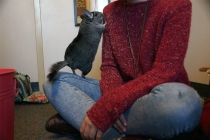
Aefa the comfort chinchilla pauses after exploring the room. Photo by Megumi Gomyo.
Freshman Rachel Szpara has no ordinary dorm room. Underneath her loft bed is not a laundry basket or food storage, but a multi-level wire cage housing a hyperactive chinchilla named Aefa.
Gone are the days of service animals exclusively serving the visually impaired. Several residential students on campus cohabit with comfort animals, which are typically used to cope with symptoms of various mental illnesses.
Szpara, a resident of the Humanities LLC in Harbor Hall, is pursuing degrees in Asian studies and modern languages and linguistics with a focus on Chinese and Korean. She has obsessive-compulsive disorder and dysthymia, otherwise known as persistent depressive disorder.
“[People with mood disorders] often just want to be alone and don’t want to be with people,” she said. “An animal presence is more comforting.”
Concerned about the transition and moving away from home, she began looking in to the process of getting a comfort animal for school last summer. After contacting Student Disability Services, she obtained documentation from several physicians and waited for her approval. About six weeks later, it came.
Residential Life policy prohibits pets and animals (other than fish) in any residential facilities. It notes that service animals are permitted to access the areas in which their owner lives. While it does not mention comfort animals specifically, the Rights and Responsibilities goes on to say that, “Animals that are known to Residential Life Operations as an approved accommodation through Student Disability Services [are also permitted].”
Students interested in bringing a comfort animal on to campus must make arrangements with Student Disability Services and Residential Life. These requests are handled on a case-by-case basis.
Junior music major Jackie Smedley described the process as “exceedingly complicated.” She sent a letter from her counselor which was sent back because it was not specific enough. After the letter was deemed acceptable, she had to fill out a long form and wait for it to be approved.
Smedley, who has panic disorder, generalized anxiety disorder and depression, eventually received permission to bring her year-old cat, Furmata, to campus.
Following approval for her second year, Smedley had trouble getting Furmata into the residential hall due to the concerns of other residents and logistical issues. This year, she lives in Terrace Apartments. Fortunately, Furmata is a hit with her new roommates.
It’s not just cats that are popular with the student population. Sophomore environmental science and psychology double major Briana Yancy resides in Erickson Hall with her shih tzu, Teddy.
“People are really cool with it; he’s really friendly,” she said.
Yancy has found Teddy, now six months old, to be a tremendous help in coping with her anxiety, which often manifests itself in panic attacks. She is considering training Teddy as a service dog so that he will be permitted to accompany her in public places such as stores and restaurants.
The effectiveness of these furry sidekicks is not hard to prove: “My anxiety was bad when I started college—I had several panic attacks a week. Since getting Teddy, I’ve had one panic attack this entire semester,” Yancy said.
The post Furry friends offer comfort, camaraderie appeared first on The Retriever.





